The spotter is an important figure that allows us to train with more intensity in the gym. This person assists us in taking our set beyond muscle failure safely. However, you have to know how to spot . If you do not know how to perform this job well, it is better that you do not offer for it. Seriously, it could be very dangerous for the person you are assisting. This is the most comprehensive guide you'll find on spotters. First of all, let's find out the meaning.
What is a spotter?
A spotter is an observer. In principle, this word was used to designate people fond of observing and registering airplanes or other vehicles. Spotters are dedicated to seeing and taking pictures of planes, trains, ships or cars. There are also bird spotters, who are dedicated to the observation and photography of birds.
In the field of fitness, the spotter observes another user of the gym while he is doing an exercise. His mission is to assist the observed person if he misses a rep so that he doesn't get trapped under the bar. As you can guess, spotters are more important in exercises like the bench press or the bar squat. In these movements, the person would have to exert a lot of effort to get free of the bar if she got caught on a missed repetition, especially if she was carrying a considerable weight.
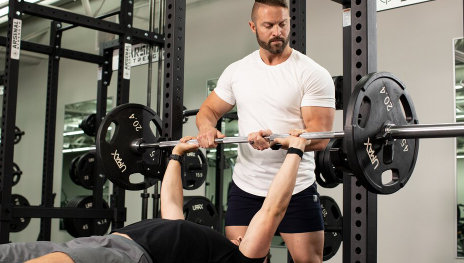
Is the spotter gym a training partner?
Not necessarily, although it is highly recommended. As we will see, he has to be a trustworthy person, who knows the technique of the exercises very well and, above all, who knows what he is doing. For this reason, there is nothing better than having a friend or training partner act as a spotter.
However, not all of us are lucky enough to have a training partner. So, in many cases, the spotter is any random person in the gym who we ask for help if we're not sure we're going to complete our reps. In these cases, the person should be someone who has helped us on other occasions and whom we trust. For example, someone who has a lot of training experience or a qualified instructor.
If you don´t know someone well or aren't sure of their spotting skills, don't ask them for help! The person could help you incorrectly and you would injure yourself. And it wouldn't be his fault!
Why a good spotter in the gym could help us
You already know what a spotter is in the gym and the meaning of the word. Now, let's dive into all the benefits of having the help of a spotter. Someone can easily lift weights alone, try to do a big lift, and pull it off. But by the time he doesn't get it, he regrets not asking for help. The spotter is important to avoid injuries in the gym.
If you don't have a training partner to watch you, you can ask someone you trust if they can watch you during your lift. If the latter is not an option for you, you may want to consider reducing the weight or leaving a possible PR (personal best) for further training.
Historically, gym spotters have been used to help guide the trajectory of weights, provide external motivation, and assist if the lifter is unable to rack the weight back. During the execution of certain exercises, it is recommended to have an observer for safety to avoid injury or muscle damage. Although the use of training partners is widespread, there is little evidence-based scientific guidance on when and how to spot.
Spotters in the gym are not meant to lift the weights for you, but they can help you. Think about the last time you struggled to get the bar back into the rack while bench pressing. A spotter can give you an extra push to help you lift the weight and avoid possible injury.
While there is no research data on spotters in the gym, some studies can give us confidence, not just anecdotal evidence, that spotters are beneficial in the gym. One study examined the presence of spotters while trained participants in their 21s performed the bench press. In this study, those who had a spotter present during the exercise were able to lift more weight , do more repetitions, and lower their perceived exertion score. This means that a spotter not only provides more security, but can also help you lift more pounds and feel the workload better.
And is it safe to ask someone of the opposite sex to watch you? Yes. It's not really a question of the person's sex, but of her skill and experience as a spotter in training. This function can be performed very well by a trained man or woman. In fact, another study concluded that there is no significant difference between being helped by a man or a woman when doing one repetition maximum (1RM).
The main reason to recommend a spotter is the benefit of security. The most common injuries during bodybuilding and strength training are self-inflicted due to falling weights, getting caught on the bar, or hitting the plates. If we want to improve our training confidence, increase the volume of forced repetitions, and improve performance and motivation, we will ask for the help of a person who observes us whenever we can in the gym.
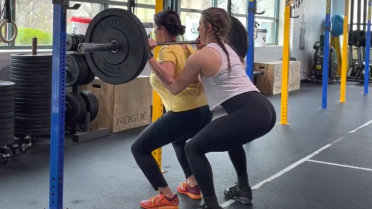
What should a good gym spotter be like?
If you are going to need a spotter in training , better look for a person who meets the following essential characteristics. Or if you want to become a good gym spot yourself , take note of this!
Communication must be effective to help in the gym
Communication is the most important element in achieving an effective gym spot . The spotter should ask the athlete a few questions before going under the bar. For example, if you need help getting the weight off the rack, how many reps you intend to do, if you are going to be nearing muscular failure on the next set, and in what position you should help the athlete when he is about to reach technical failure . In addition, the spotter must provide feedback to the athlete on his form and technique during the exercise. The ability to communicate effectively with the athlete makes observation more productive and safe.
You must know the technique of the exercises very well
The observer must understand the complete technique of the exercise that the athlete is performing. Without this, the risk of injury to the athlete is increased because the spotter cannot determine which part of the lift is the difficult spot and when would be the ideal time to assist the athlete. The observer must also be familiar with the different variations of the exercise and the muscles involved in each variation. Only with this knowledge can the spotter provide accurate and effective assistance.
The spotter must know the equipment
A spotter must understand the equipment used in training, as it is essential to help the lifter perform the exercise in a safe and correct manner. In addition, the spotter should check the material before using it (for example, to make sure that the wires, nuts or bolts of a machine are not loose). The spotter must also know how to use the safety devices and adjust the equipment to the athlete's body size and training requirements.
Someone strong enough
One of the goals of a gym spotter is to ensure the athlete's safety and prevent injury in the event of a sudden failure. The spotter does not necessarily need to lift the full weight of the bar, but must have sufficient strength to assist the athlete if the athlete fails a lift, to remove the load from the racks or reattach the weight. The spotter must be physically able to assist the athlete in case his technique fails or he suddenly loses control.
Maintain correct posture
The observer's body language is crucial to ensure that the athlete performs the exercise in a safe manner. The position of the spotter's body in relation to the stance must be well planned before rendering assistance. The body position is slightly different in free weight exercises compared to machine exercises. The spotter must maintain a stable stance with feet shoulder-width apart and be ready to assist the athlete at any time during the exercise. A gym spotter should also be in a position that provides the necessary leverage and support to the athlete during the lift.
Effective communication, technical and equipment knowledge, the adequacy of force and the position of the spotter allow the athlete to be given the necessary support to perform the exercise safely and effectively.
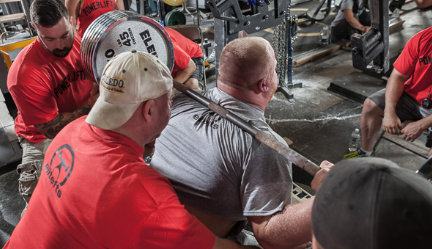
What should a spotter or gym helper do in different exercises
Remember that not all gym exercises require a spotter. The spotter is required in movements that involve heavy weights and where there is a risk of the lifter getting stuck. The two most critical exercises where you need a spotter if you are going to be moving heavy loads (and you don't have the safety equipment in the rack) are the squat and the bench press. Definitely, failing a repetition in the squat without having a helper can be fatal and even dangerous.
In other moves, the spotter is not as necessary or may even be counterproductive. For example, in the deadlift. In this exercise, failing the repetition does not imply risk because the athlete can release the bar from his hands whenever he wants. Furthermore, attempting to assist the lifter when he is failing the rep (by touching his body or the bar) could cause an injury on this exercise.
How to be a spotter in bench press
If you're asked for help on the bench press, often the lifter will want you to lend a hand to get the bar out of the rack. This simply means that you will be giving him a little help lifting the bar off the rack.
How to "spot" ? Stand behind the bar with your feet shoulder-width apart. Grab the bar from the middle at a distance of one span. Wait for the lifter's signal. Then gently help him lift the bar up and out of the rack. Make sure the bar is in the correct position to bench press (above chest). Then make sure the lifter is ready to start doing the reps.
When the athlete is lifting the weight, don't touch the bar , but keep your hands close together and in a mixed grip (ie, one palm facing you and the other facing away).
If the lifter needs help, don't yank the bar up hard. Instead of doing this, follow the person's movement. Let the person do as much of the effort alone as possible.
If the bar goes down or the lifter calls for your help, this is where you should lift the bar with all your might and immediately put it back in the rack.
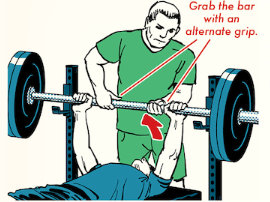 |
| Hand the bar to your partner with a mixed grip as shown in the image. |
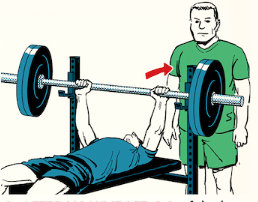 |
| When the person is in the starting position, you can back off a bit. Stay out of his field of vision, but keep an eye on the bar. |
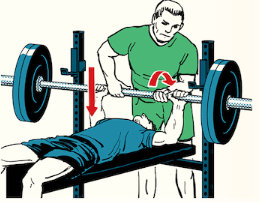 |
| When it's time to help out, accompany the movement of the bar with a mixed grip. Use just enough force to allow the person to complete another repetition. |
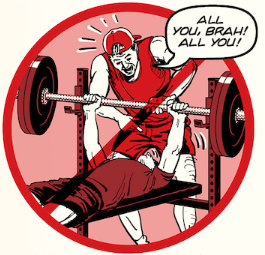 |
| Wrong . Don't help with one hand. |
How to be a spotter in the squat
Being a spotter at the squat gym is pretty easy. You just have to keep your hands next to the lifter's obliques and move at the same speed as him to accompany the lift. Always stand behind the setter a short distance, but do not interfere with his movement.
If the person has difficulty standing up, place your arms around their torso over their chest or shoulders. Help him as much as you can to his feet and guide the bar to the rack.
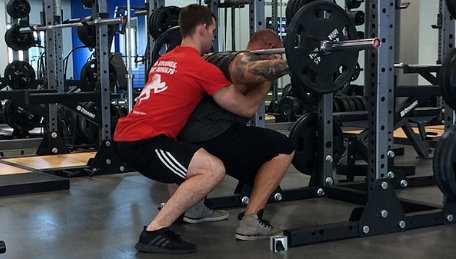 |
| Wrap your arms around the person below their elbows. When you have to assist in the lift, grab the person by the chest or shoulders and help them up. |
How to be a spotter on the dumbbell military press
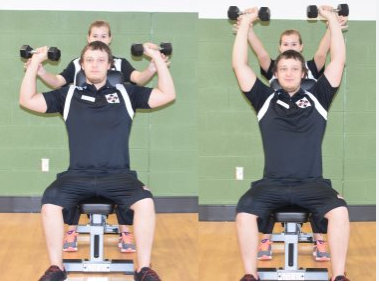
You might think that the best way to be a spotter on military press is to put your hands under the lifter's elbows. However, this approach can be dangerous because you don't support his wrists if his hands give way. As a result, the weight would fall directly on the head.
A better alternative is to stand behind the person and grab their wrists. Lift their wrists up if they need help, but let the person exert as much effort as possible during the lift. It's not about you doing the exercise! If you see that the lifter needs help getting the dumbbells onto his shoulders, get behind him and move in close to help him lift the weight.
Spotter techniques in the gym
Training with a spotter in the gym is not only safer, but also allows us to take our training much further. Thanks to a good spotter, we will be able to apply various intensity techniques that we could not carry out if we trained alone. Let's look at some of the more popular assistive techniques.
Reaching muscle failure
Training with a spotter allows us to safely reach muscle failure in exercises like the bench press or squat. It allows us to get the most out of a training sets without fear of injury. When we fail, the spotter will help us lift the bar to put it back in the rack.
Forced reps
Thanks to a spotter, we can use this training technique. This consists of reaching muscular failure (where we cannot complete more repetitions) and doing a few more repetitions with the help of the partner. Really, the spotter should help just enough to get us to complete a few more reps after failing. It is an intensity technique for bodybuilding that allows us to exceed the limits and go far beyond muscular failure.
Negative reps
You have to be very careful with this technique, which can come in handy on certain occasions. However, a spotter with good knowledge is required. It consists of placing a weight that we could not lift by ourselves and doing only the eccentric phases of the exercise. The assistant must assist us to lift the weight (applying all his strength in this case) and we will control the lowering of the weight or negative phase.
For example, suppose we are only capable of bench pressing 80 kg. To apply the negative repetitions, we would place 90 kg. The bench press spotter would help us lift the bar off our chest. We would take care of holding the weight of the bar when going down.
Negative reps should not be abused, as they could be dangerous even with a good spotter. Keep in mind that you will be holding more weight than you could lift on your own.
Forced and negative reps also work great in exercises like the barbell biceps curl or the lat pulldown .
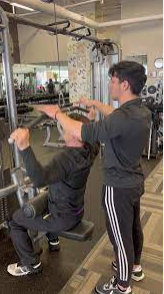
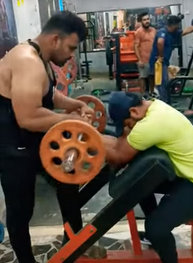
Drop sets
The drop set is another technique widely used in bodybuilding that also requires the assistance of a partner. In this case, one person has to take weight off the bar every time we reach failure so we can do one more set.
This technique requires speed and good coordination on the part of the spotter, who will have to watch us immediately after unloading the weight. Let's see an example. Let's say you bench press 90kg (a 10kg bar and 4 x 10kg plates on each side). You start the sets, do 5 repetitions and reach muscular failure. Immediately, your spotter removes a 10 kg plates from each side. Now, you are benching 70 kg and you do 10 repetitions. Your spotter removes another two plates. Now, with 50 kg, do 14 repetitions and you reach failure. Then the person assisting you removes another two 10 kg plates. You end up with 30kg on the bar and do 20 reps to failure.
All sets must be done without rest. As you can see, the descending set or drop set is another technique that allows us to go far beyond normal muscular failure. It's a challenge.
Exercises where a drop set can be easily applied are the bench press, barbell biceps curl, leg press, or barbell row. In all of them, it is better to have a partner take the plates from us.
To learn more about these techniques, read the following post:
Bodybuilding training with intensity techniques
How to train without a spotter?
Finally, let's see what options there are if we can't count on a spotter. As we will see, sometimes it is not necessary to have an observer in the bench press or squat if our gym has equipment with security systems. If you don't count on safety holders, our last piece of advice is not to take chances with weights that could fail you in the bench press or squat. We understand that it can be frustrating not to push ourselves to our limits, but you don't want to have a hard time under the bar either.
If you don't have anyone to supervise you or safety bars on the racks, choose a weight you're sure you'll be able to lift. Do the exercise and always stay 3 or 4 repetitions away from failure.
What solutions exist to train without a spotter in the gym safely?
Bench Press with Safety Holds
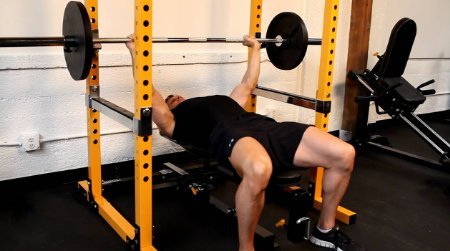
They are two holders that protrude from the poles of the bench press. If you fail, the bar will stay on top of the holders and you can easily escape under it. Not all gyms have this.
If your bench press doesn't have the safety system, you can also "learn to fail" and take a chance. This is not the most recommended, obviously, but if you have some experience, you may get used to doing it.
If you fail in the bench press, the first thing is not to be alarmed or nervous. If you have good technique, the bar should have landed on your chest. If you can't get the bar off your chest, roll it forward with your wrists until you bring it to your thighs. Then push yourself up and raise your torso. You will remain seated on the bench with the bar over your legs. From here, you can easily get rid of the weight.
Another option is not to place the clamps or safety threads at the ends of the bar. If you were to fail the lift, you could tip the bar to the side so the plates fall to the floor. Then, you will do the same by tilting the bar to the other side.
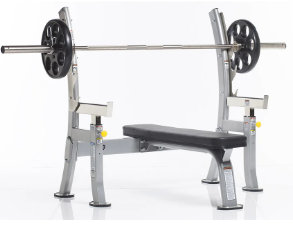 |
| Example of bench press with built-in safety holders. |
Safety holders on the squat rack
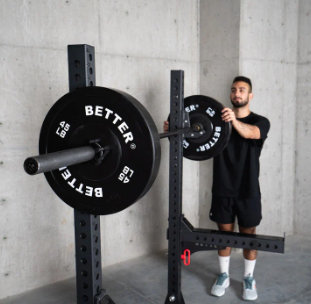 | 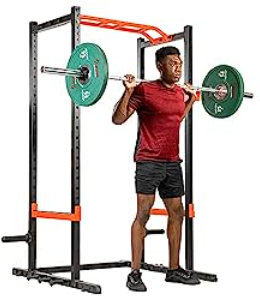 |
| Rack squat with holders. | Power rack with safety bars. |
A squat stand or rack will have a pair of safety bars that sit below the athlete's torso. The idea is that the load will stay on these safety holders if the lifter fails the lift. The athlete will be able to easily exit under the bar, without risk of injury. In many racks, the safety holders are height adjustable. This is the best way to do a heavy squat without a spotter.
If you don't have a spotter or safety bars in your rack, our advice is not to risk doing a heavy squat. Not worth it. You could seriously injure your legs or back if you can't control the weight.
If one day you have failed the exercise without a spotter or safety systems, what you should do is drop the bar behind your back. This is the safest way to escape a failure.
The Multipower machine
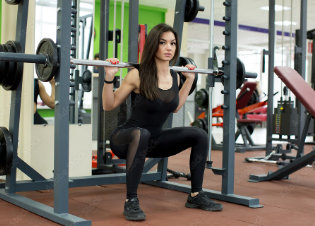
The Multipower or Smith machine is our third recommendation for training without a spotter. This machine is in many gyms. It's like a rack, but it has rails that guide the bar. The apparatus poles have a toothed system that allows the bar to be repositioned at any point of failure.
Actually, there is no risk. When you fail, just twist your wrists and hook the bar into the rack's teeth. Although the Multipower machine is not as recommended as the free weight, it can save the day if we don't have a spotter. In addition, you can do a variety of exercises on this apparatus: bench press, shoulder press, squats...
How to prepare to "spot" a person at the gym
Spotter at the gym for the first time can be stressful. With a few tips, you can reduce your anxiety, increase your ability to keep the person safe, and help them gain a better footing. Before beginning a strength training program with a partner, pre-lift communication is an important part of good teamwork. Only then will you achieve a safe lifting. Agree together if you are going to assist in removing the bar from the rack, what the goals of the sets and reps are, or what type of cue the lifter will use to request assistance. Make sure you know what to expect and what is required of you before the other person starts lifting the weights. Communication is key. Does the lifter need help getting the weight out of the rack? Does the lifter need you to control the weight or does he just want someone to grab the bar if he can't keep up the reps? Also, how many repetitions is the person looking to do? Everything must be discussed and made clear before a series begins. Do you have a spotter?





![LAS MEJORES MÁQUINAS DE MUSCULACIÓN PARA PRINCIPIANTES [GUÍA 2025]](/modules//smartblog/images/no-home-small.jpg)
![HOW TO BUILD A HOME GYM ON A BUDGET [2024 GUIDE]](/modules//smartblog/images/296-home-small.jpg)


